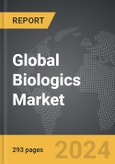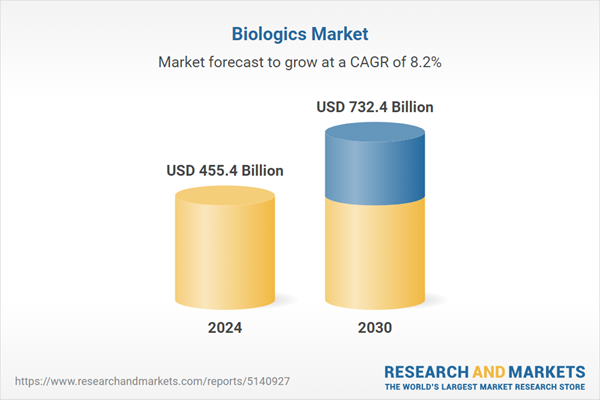The global market for Biologics was valued at US$455.4 Billion in 2024 and is projected to reach US$732.4 Billion by 2030, growing at a CAGR of 8.2% from 2024 to 2030. This comprehensive report provides an in-depth analysis of market trends, drivers, and forecasts, helping you make informed business decisions. The report includes the most recent global tariff developments and how they impact the Biologics market.
The growth in the biologics market is driven by several factors, including advancements in biotechnological research, the increasing prevalence of chronic and autoimmune diseases, and the growing adoption of personalized medicine. Rising demand for targeted therapies that minimize side effects while maximizing treatment efficacy is also fueling the market. Furthermore, biosimilar approvals in regions like Europe and the U.S. are expanding access to biologic therapies at lower costs, while technological innovations in biomanufacturing are streamlining production processes. The expanding application of biologics in oncology, immunology, and rare diseases, coupled with favorable regulatory environments, is expected to sustain the strong growth trajectory of the biologics market.
Segments: Application (Infectious Diseases, Oncology, Autoimmune Diseases, Diabetes, Other Applications); Product Type (Recombinant Therapeutic Proteins, Blood & Blood components, Cellular & Gene Therapy, Vaccines).
Geographic Regions/Countries: World; United States; Canada; Japan; China; Europe (France; Germany; Italy; United Kingdom; and Rest of Europe); Asia-Pacific; Rest of World.
The analysts continuously track trade developments worldwide, drawing insights from leading global economists and over 200 industry and policy institutions, including think tanks, trade organizations, and national economic advisory bodies. This intelligence is integrated into forecasting models to provide timely, data-driven analysis of emerging risks and opportunities.
Global Biologics Market - Key Trends & Drivers Summarized
What Is Driving the Surge in Biologics?
Biologics, or biological drugs, have emerged as a revolutionary category of therapeutics, transforming the treatment landscape for chronic and complex diseases. These large, complex molecules are derived from living cells and are engineered to target specific components of human biology, making them highly effective for conditions like cancer, autoimmune disorders, and rare genetic diseases. As more diseases are linked to genetic or molecular causes, biologics are taking center stage in the treatment of previously untreatable conditions, offering unprecedented precision and efficacy. The growing understanding of biological pathways in the human body, combined with advances in biotechnology, has made biologics a cornerstone of modern medicine.How Are Technological Advancements Reshaping the Biologics Landscape?
Biologics are benefiting from cutting-edge advancements in biotechnology, particularly in gene editing technologies like CRISPR and developments in monoclonal antibodies and cell-based therapies. Innovations such as CAR-T therapy, which uses a patient’s immune cells to fight cancer, are pushing the boundaries of what biologics can achieve. Furthermore, advancements in biomanufacturing techniques, including continuous manufacturing and single-use technologies, are helping scale biologics production while reducing costs. These technologies are also enabling greater control over product consistency and quality, which is crucial for the commercial viability of biologics. Additionally, the rise of biosimilars is allowing more patients access to affordable biologic therapies, accelerating their market penetration globally.What Is the Market Demand for Biologics Across Healthcare Sectors?
Biologics are widely used in various therapeutic areas, from oncology and immunology to endocrinology and infectious diseases. The increasing incidence of chronic diseases, such as diabetes, rheumatoid arthritis, and multiple sclerosis, has spurred demand for biologic therapies that offer improved outcomes over traditional small-molecule drugs. In oncology, biologics such as immunotherapies and targeted therapies have significantly improved survival rates and reduced relapse. With aging populations and the rise in autoimmune diseases, the need for long-term, effective biologic treatments is expanding. The pharmaceutical sector is also seeing a surge in R&D investment, with major companies focusing on the development of novel biologics that address unmet medical needs, particularly for rare and orphan diseases.The growth in the biologics market is driven by several factors, including advancements in biotechnological research, the increasing prevalence of chronic and autoimmune diseases, and the growing adoption of personalized medicine. Rising demand for targeted therapies that minimize side effects while maximizing treatment efficacy is also fueling the market. Furthermore, biosimilar approvals in regions like Europe and the U.S. are expanding access to biologic therapies at lower costs, while technological innovations in biomanufacturing are streamlining production processes. The expanding application of biologics in oncology, immunology, and rare diseases, coupled with favorable regulatory environments, is expected to sustain the strong growth trajectory of the biologics market.
Report Scope
The report analyzes the Biologics market, presented in terms of units. The analysis covers the key segments and geographic regions outlined below.Segments: Application (Infectious Diseases, Oncology, Autoimmune Diseases, Diabetes, Other Applications); Product Type (Recombinant Therapeutic Proteins, Blood & Blood components, Cellular & Gene Therapy, Vaccines).
Geographic Regions/Countries: World; United States; Canada; Japan; China; Europe (France; Germany; Italy; United Kingdom; and Rest of Europe); Asia-Pacific; Rest of World.
Key Insights:
- Market Growth: Understand the significant growth trajectory of the Recombinant Therapeutic Proteins segment, which is expected to reach US$271.3 Billion by 2030 with a CAGR of a 8.8%. The Blood & Blood components segment is also set to grow at 7.5% CAGR over the analysis period.
- Regional Analysis: Gain insights into the U.S. market, valued at $127.6 Billion in 2024, and China, forecasted to grow at an impressive 7.6% CAGR to reach $111.9 Billion by 2030. Discover growth trends in other key regions, including Japan, Canada, Germany, and the Asia-Pacific.
Why You Should Buy This Report:
- Detailed Market Analysis: Access a thorough analysis of the Global Biologics Market, covering all major geographic regions and market segments.
- Competitive Insights: Get an overview of the competitive landscape, including the market presence of major players across different geographies.
- Future Trends and Drivers: Understand the key trends and drivers shaping the future of the Global Biologics Market.
- Actionable Insights: Benefit from actionable insights that can help you identify new revenue opportunities and make strategic business decisions.
Key Questions Answered:
- How is the Global Biologics Market expected to evolve by 2030?
- What are the main drivers and restraints affecting the market?
- Which market segments will grow the most over the forecast period?
- How will market shares for different regions and segments change by 2030?
- Who are the leading players in the market, and what are their prospects?
Report Features:
- Comprehensive Market Data: Independent analysis of annual sales and market forecasts in US$ Million from 2024 to 2030.
- In-Depth Regional Analysis: Detailed insights into key markets, including the U.S., China, Japan, Canada, Europe, Asia-Pacific, Latin America, Middle East, and Africa.
- Company Profiles: Coverage of players such as AbbVie, Inc., Amgen, Inc., AstraZeneca PLC, Bristol-Myers Squibb Company, Celgene Corporation and more.
- Complimentary Updates: Receive free report updates for one year to keep you informed of the latest market developments.
Some of the 243 companies featured in this Biologics market report include:
- AbbVie, Inc.
- Amgen, Inc.
- AstraZeneca PLC
- Bristol-Myers Squibb Company
- Celgene Corporation
- Eli Lilly and Company
- GlaxoSmithKline PLC
- Janssen Pharmaceuticals, Inc.
- Merck & Co., Inc.
- Novartis AG
- Novo Nordisk A/S
- Pfizer, Inc.
Tariff Impact Analysis: Key Insights for 2025
Global tariff negotiations across 180+ countries are reshaping supply chains, costs, and competitiveness. This report reflects the latest developments as of April 2025 and incorporates forward-looking insights into the market outlook.The analysts continuously track trade developments worldwide, drawing insights from leading global economists and over 200 industry and policy institutions, including think tanks, trade organizations, and national economic advisory bodies. This intelligence is integrated into forecasting models to provide timely, data-driven analysis of emerging risks and opportunities.
What’s Included in This Edition:
- Tariff-adjusted market forecasts by region and segment
- Analysis of cost and supply chain implications by sourcing and trade exposure
- Strategic insights into geographic shifts
Buyers receive a free July 2025 update with:
- Finalized tariff impacts and new trade agreement effects
- Updated projections reflecting global sourcing and cost shifts
- Expanded country-specific coverage across the industry
Table of Contents
I. METHODOLOGYII. EXECUTIVE SUMMARY2. FOCUS ON SELECT PLAYERSIII. MARKET ANALYSISIV. COMPETITION
1. MARKET OVERVIEW
3. MARKET TRENDS & DRIVERS
4. GLOBAL MARKET PERSPECTIVE
UNITED STATES
CANADA
JAPAN
CHINA
EUROPE
FRANCE
GERMANY
ITALY
UNITED KINGDOM
REST OF EUROPE
ASIA-PACIFIC
REST OF WORLD
Companies Mentioned (Partial List)
A selection of companies mentioned in this report includes, but is not limited to:
- AbbVie, Inc.
- Amgen, Inc.
- AstraZeneca PLC
- Bristol-Myers Squibb Company
- Celgene Corporation
- Eli Lilly and Company
- GlaxoSmithKline PLC
- Janssen Pharmaceuticals, Inc.
- Merck & Co., Inc.
- Novartis AG
- Novo Nordisk A/S
- Pfizer, Inc.
Table Information
| Report Attribute | Details |
|---|---|
| No. of Pages | 293 |
| Published | April 2025 |
| Forecast Period | 2024 - 2030 |
| Estimated Market Value ( USD | $ 455.4 Billion |
| Forecasted Market Value ( USD | $ 732.4 Billion |
| Compound Annual Growth Rate | 8.2% |
| Regions Covered | Global |









